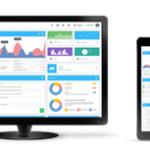The need for Ajax
What do web applications accomplish? First of all, web applications can allow the web designer and developer the chance to solve a problem that the website owner may not even know existed. On the flip side, a web application can be slow and tedious, slowing down the website and degrading the user experience. This is the most dreaded action — or lack of action — for a web site owner to face.
In the traditional web application, the interaction between the customer and the server goes like this:
- Customer accesses web application
- Server processes request and sends data to the browser while the customer waits
- Customer clicks on a link or interacts with the application
- Server processes request and sends data back to the browser while the customer waits
- And the process starts over
This entire process can be quite slow. Slow web applications can cause users to leave the website and find a faster site all together. Let’s face it, time is of essence, we are not going to spend too much time in one area for nothing. When a web application is slow, it is because the web application is trying to contact the server, and the server is thinking about what it is going to send back, and the hour glass appears and time ticks away waiting…waiting… a visitor is most likely to get irritated, fed up and leave the website with a negative impression that can hurt your brand image. This is where Ajax comes in.
Ajax is a way of developing web applications that combine:
- XHTML and CSS standards based presentation
- Interaction with the page through the DOM
- Data interchange with XML and XSLT
- Asynchronous data retrieval with XMLHttpRequest
- JavaScript to tie it all together
What can change this outcome of reloading, refreshing, and the lag time? Ajax can.
What is Ajax used for?
Ajax is a program that helps you get rid of the waiting and the hourglass while a web application loads. Data content and design are put together to streamline efforts. This allows your customer to click on a desired product or service or any page in the website on an Ajax driven application, and have very little lag time. Almost instantaneously the page displays, there is no lag time, or wait for the page to load or refresh. This improves page load time, reduces waiting, enhances user experience and helps you build a favorable brand image among your visitors.
The Ajax engine works within the Web browser, most often through JavaScript and DOM, to help the Web applications proceed with any requests of the Web server. Since the Ajax engine handles the requests in the engine itself, this allows the interaction with the application and the customer to happen in sync independently of any other interaction with the server. This means that one has to happen after the other in sequence of order. The customer clicks a link, the request is sent to the server, and the server then sends the results back to the customer.
Ajax is not new Technology
Ajax is not new. What is new however, is how we are now looking at technology. Ajax is mature and stable and has been around for awhile. If you’re designing web applications, you should be using Ajax, if you’re not using Ajax, why not? Ajax is a fun way to get your customers to think you’re brilliant and thank you more times over.
Ajax and SEO
There is a common misconception that Ajax is not search engine friendly and should be avoided if you want your website to rank in search results. This is not true. What impacts SEO is WHAT do you use Ajax for. If you use Ajax for serving content on your website, it will impact your SEO and hurt your rankings. It is important to understand where a technology is applicable and use it judiciously. Ajax is best with web applications. You want the content of your website — and not the web application — to feature in search results. When used intelligently, Ajax can actually help you manage what features in search results and what doesn’t. It can be a powerful SEO tool when used by professionals who understand the technology, SEO and its correct use.
Professional Web Design Services from Flying Cow Design
Flying Cow Design has a track record of over 20 years of professional web design. What differentiates us from most web design companies is that our focus is not only on web design, but on building a strong online presence for our clients. Understanding the changing web development standards and search engine guidelines has helped us build a strong web presence for many of our clients through a combination of our web design and internet marketing services. To see how we can help you build a strong web presence, write to us today!
CEO, Flying Cow Design
Attended University of Auckland
Lives in San Francisco Bay Area










